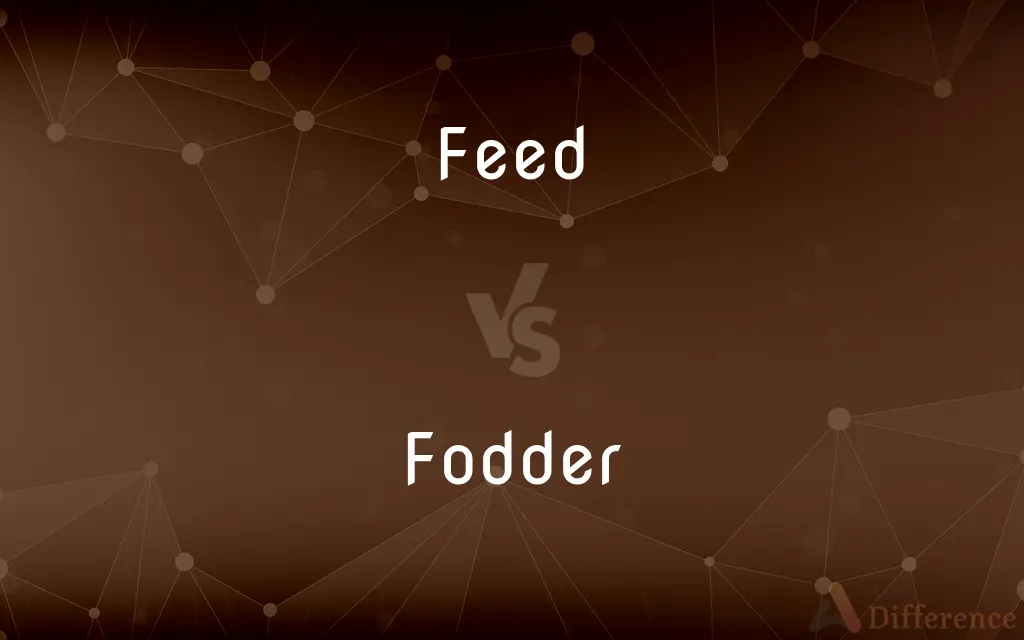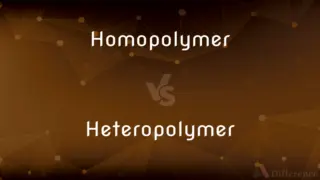Feed vs. Fodder — What's the Difference?
Edited by Tayyaba Rehman — By Urooj Arif — Updated on February 26, 2024
Feed refers to food given to domestic animals, often processed or mixed for specific dietary needs, while fodder is raw agricultural food such as hay or straw, primarily for livestock.

Difference Between Feed and Fodder
Table of Contents
ADVERTISEMENT
Key Differences
Feed encompasses a broad range of animal food, including grains, pellets, and specially formulated diets designed to meet the nutritional requirements of domestic animals. It can be commercially produced or home-mixed, with precise ingredients to support health, growth, and productivity. Fodder, on the other hand, refers to agricultural crops like hay, silage, and straw, intended for livestock consumption. These are usually grown and harvested by the livestock owners or purchased in their natural form.
The term "feed" suggests a more processed or refined diet, often tailored for specific types of animals, such as poultry, swine, or pets, focusing on optimizing the animals' performance and health outcomes. Fodder typically involves less processing and includes whole plants or plant parts that animals can consume directly. It is essential for providing the necessary fiber and basic nutrients to ruminants and other livestock.
Feed can be nutritionally complete, offering a balanced diet with vitamins, while minerals, and other nutrients, fodder might need to be supplemented with additional feed or nutritional supplements to ensure animals receive a balanced diet. This distinction highlights the feed's role in intensive farming and pet care, where nutritional precision is critical, compared to fodder's role in traditional and extensive livestock farming.
The choice between feed and fodder can depend on factors such as the type of animal, the desired nutritional outcomes, farming practices, and economic considerations. Intensive farming operations might rely more on scientifically formulated feeds, whereas extensive systems might utilize fodder as a significant component of animal diets.
Both feed and fodder play crucial roles in animal nutrition, but their usage and preparation differ significantly, reflecting the diversity of agricultural practices and animal rearing methods. Understanding these differences is essential for effective livestock management and achieving desired health and productivity outcomes.
ADVERTISEMENT
Comparison Chart
Definition
Food given to domestic animals, often processed or mixed for specific dietary needs.
Raw agricultural food such as hay or straw, primarily for livestock.
Composition
Processed grains, pellets, and specialized diets.
Raw plants or plant parts like hay, silage, and straw.
Processing
Often processed to enhance digestibility and nutritional value.
Minimal processing, consumed in natural form.
Nutritional Completeness
Designed to be nutritionally complete.
May need supplementary feed for a balanced diet.
Usage
Used in intensive farming and pet care for specific nutritional needs.
Used in traditional and extensive livestock farming for basic nutrition.
Compare with Definitions
Feed
A formulated diet for animals.
The farmer bought chicken feed to ensure his poultry had the right nutrients.
Fodder
Agricultural crops for livestock.
The farmer stored hay in the barn for winter fodder.
Feed
Includes vitamins and minerals.
This pig feed is fortified with essential vitamins to promote growth.
Fodder
Includes hay, silage, and straw.
They rotated between different types of fodder to maintain the cattle's health.
Feed
Often processed into pellets or meal.
The feed mill produces cattle feed in both pellet and meal form.
Fodder
Part of extensive farming practices.
Fodder crops are an essential part of their extensive grazing system.
Feed
Can be tailored for specific animals.
She purchased a special feed formulated for her elderly dog's dietary needs.
Fodder
Provides basic nutrients and fiber.
Ruminants rely on fodder like hay for fiber and basic nutrition.
Feed
Supports health and productivity.
Using high-quality feed has improved the health and milk yield of the dairy cows.
Fodder
Less processed than feed.
He prefers to use natural fodder instead of highly processed feeds for his livestock.
Feed
To give food to; supply with nourishment
Feed the children.
Fodder
Fodder (), also called provender (), is any agricultural foodstuff used specifically to feed domesticated livestock, such as cattle, rabbits, sheep, horses, chickens and pigs. "Fodder" refers particularly to food given to the animals (including plants cut and carried to them), rather than that which they forage for themselves (called forage).
Feed
To provide as food or nourishment
Fed fish to the cat.
Fodder
Feed for livestock, especially coarsely chopped hay or straw.
Feed
To serve as food for
The turkey is large enough to feed a dozen.
Fodder
Food for animals; that which is fed to cattle, horses, and sheep, such as hay, cornstalks, vegetables, etc.
Feed
Food for animals, especially livestock.
Fodder
Coarse food (especially for cattle and horses) composed of entire plants or the leaves and stalks of a cereal crop
Feed
The act of supplying such material.
Fodder
Give fodder (to domesticated animals)
Feed
To fill the wants of; to supply with that which is used or wasted; as, springs feed ponds; the hopper feeds the mill; to feed a furnace with coal.
Feed
To nourish, in a general sense; to foster, strengthen, develop, and guard.
Thou shalt feed my people Israel.
Mightiest powers by deepest calms are fed.
Feed
To give for food, especially to animals; to furnish for consumption; as, to feed out turnips to the cows; to feed water to a steam boiler.
Feed
To supply (the material to be operated upon) to a machine; as, to feed paper to a printing press.
Feed
To be nourished, strengthened, or satisfied, as if by food.
Feed
A meal, or the act of eating.
For such pleasure till that hourAt feed or fountain never had I found.
Feed
Serve as food for; be the food for;
This dish feeds six
Common Curiosities
Is feed more expensive than fodder?
Generally, yes, due to its processing and the inclusion of vitamins, minerals, and other nutritional supplements.
How do farmers choose between feed and fodder?
Choices are based on animal nutritional requirements, cost, availability, and farming practices.
Can fodder alone provide all necessary nutrients to livestock?
It may need to be supplemented with additional feed or nutritional supplements to ensure a balanced diet.
What is the main difference between feed and fodder?
Feed is often processed and nutritionally formulated for specific animals, while fodder is raw agricultural food like hay or straw for livestock.
What role does fodder play in animal health?
It provides essential fiber and nutrients, supporting digestive health and overall well-being in livestock.
Is it possible to grow fodder organically?
Yes, many farmers grow organic fodder as part of sustainable farming practices.
Why is feed preferred in intensive farming operations?
Feed provides precise nutrition to maximize health, growth, and productivity in a controlled environment.
How is feed tailored for specific animals?
Through research and nutritional science, feed is formulated with specific ingredients to meet the unique dietary requirements of different animals.
Can all animals eat both feed and fodder?
While most livestock can consume fodder, specific types of feed are formulated for particular animals based on their nutritional needs.
How does the nutritional content of feed and fodder compare?
Feed is formulated to be nutritionally complete, while fodder provides basic nutrients and fiber but may lack in certain vitamins or minerals.
Can feed and fodder be used together?
Many farming operations use both to ensure animals receive a balanced diet and meet all their nutritional needs.
Can pets be given fodder?
Some pets, especially herbivores like rabbits, can benefit from fodder, but it should be appropriate for their dietary needs.
Does the use of feed or fodder affect meat quality in livestock?
Yes, the diet can influence the quality, flavor, and nutritional value of the meat produced.
How do environmental conditions affect the choice between feed and fodder?
Availability, climate, and local agricultural practices can influence whether feed or fodder is more suitable.
Are there environmental impacts associated with producing feed and fodder?
Yes, both can have environmental impacts, including land use changes, water usage, and greenhouse gas emissions, depending on how they are produced and processed.
Share Your Discovery

Previous Comparison
Liberal vs. Libertarian
Next Comparison
Homopolymer vs. HeteropolymerAuthor Spotlight
Written by
Urooj ArifUrooj is a skilled content writer at Ask Difference, known for her exceptional ability to simplify complex topics into engaging and informative content. With a passion for research and a flair for clear, concise writing, she consistently delivers articles that resonate with our diverse audience.
Edited by
Tayyaba RehmanTayyaba Rehman is a distinguished writer, currently serving as a primary contributor to askdifference.com. As a researcher in semantics and etymology, Tayyaba's passion for the complexity of languages and their distinctions has found a perfect home on the platform. Tayyaba delves into the intricacies of language, distinguishing between commonly confused words and phrases, thereby providing clarity for readers worldwide.















































